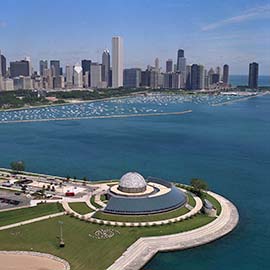The Adler Planetarium & Astronomy Museum in Chicago, Illinois was the first planetarium built in the Western Hemisphere and is the oldest in existence today.Adler was founded and built in 1930 by the philanthropist Max Adler, with the assistance of the first director of the planetarium, Philip Fox. On the occasion of its dedication on May 10, 1930, Max Adler stated.
The popular conception of the universe is too meager; the planets and the stars are too far removed from general knowledge. In our reflections, we dwell too little upon the concept that the world and all human endeavor within it are governed by established order and too infrequently upon the truth that under the heavens everything is interrelated, even as each of us to the other.
Located on Northerly Island, it is a part of Chicago's Museum Campus along with the Shedd Aquarium and the Field Museum of Natural History. For its design, architect Ernest A. Grunsfeld, Jr. was awarded the gold medal of the Chicago chapter of the American Institute of Architects in 1931. It was declared a National Historic Landmark in 1987.
 The Adler has three full-size theaters. Since the museum's opening in 1930, visitors view representations of the night sky in the historic Sky Theater planetarium, the outer protective dome of which is visible from the exterior of the building. The Zeiss Planetarium projector is capable of accurately reproducing the movement of every aspect of the night sky. In 1999, the Adler expanded its exhibition space, including the addition of the DefinitiTM Space Theater, a completely digital fulldome video environment powered by DigitalSky 2 software. Outside the Planetarium are several sculptures, one by Henry Moore is a sundial sculpture named Man Enters the Cosmos, while the second is a Neoclassical sculpture of astronomer Nicholas Copernicus, a replica of a famous 19th century work in front of Warsaw's Staszic Palace by Danish sculptor Bertel Thorvaldsen.
The Adler has three full-size theaters. Since the museum's opening in 1930, visitors view representations of the night sky in the historic Sky Theater planetarium, the outer protective dome of which is visible from the exterior of the building. The Zeiss Planetarium projector is capable of accurately reproducing the movement of every aspect of the night sky. In 1999, the Adler expanded its exhibition space, including the addition of the DefinitiTM Space Theater, a completely digital fulldome video environment powered by DigitalSky 2 software. Outside the Planetarium are several sculptures, one by Henry Moore is a sundial sculpture named Man Enters the Cosmos, while the second is a Neoclassical sculpture of astronomer Nicholas Copernicus, a replica of a famous 19th century work in front of Warsaw's Staszic Palace by Danish sculptor Bertel Thorvaldsen.

No comments:
Post a Comment